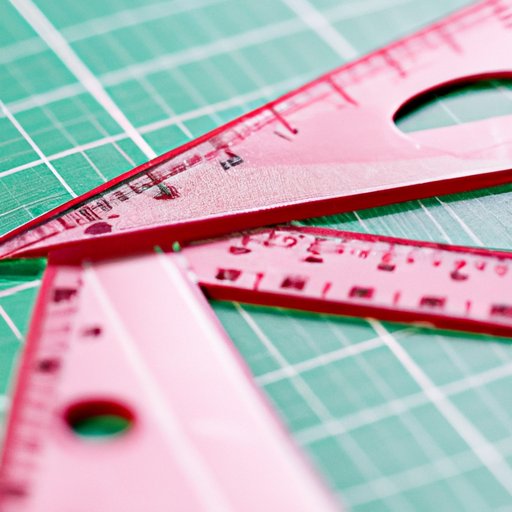
Introduction
If you’ve ever wondered how to measure angles with precision, a protractor is the tool you need. Whether you’re a student, a professional in the construction or engineering industry, or just someone who enjoys DIY projects, knowing how to use a protractor is an indispensable skill.
In this article, we’ll cover all the basics of using a protractor, including the different parts of a protractor, how it works, and step-by-step instructions for measuring angles. We’ll also discuss some tips and tricks for using a protractor efficiently, common mistakes to avoid, and alternative methods for measuring angles.
Protractor Basics
A protractor is a simple tool made of plastic or metal that helps measure angles. It includes two main parts: a flat base and a rotating dial marked with degrees from 0 to 180 or 0 to 360. The base of a protractor is typically rectangular or square, while the dial is a half-circle or full circle.
Using a protractor is straightforward: align the base of the protractor with one side of the angle to be measured, then rotate the dial until the other side of the angle lines up with a mark on the dial.
Here’s a step-by-step guide for measuring angles with a protractor:
- Place the base of the protractor on one side of the angle, making sure it lays flat against the surface.
- Align the center point of the protractor with the vertex (the point where the two sides of the angle meet).
- Rotate the dial until one of the angle’s sides aligns with the zero-degree line (the straight line at the bottom of the dial).
- Read the degree measurement where the other side of the angle intersects with the protractor dial.
If the angle you’re measuring is greater than 180 degrees, you’ll need to use the inner scale of the protractor, which is marked from 0 to 180 degrees in the opposite direction. Simply align the straight side of the inner scale with one side of the angle and read the measurement where the other side intersects with the scale.
Tips and Tricks
While using a protractor is relatively straightforward, a few tips and tricks can help you use it more efficiently:
- Use a protractor with clear markings and a visible center point for easier alignment.
- Adjust the position of the protractor for better visibility and alignment. You can turn the protractor sideways or lift one end off the surface for a better view.
- For easier measurement, use a pencil to mark the angle on the surface before aligning the protractor.
Common Mistakes to Avoid
While using a protractor is relatively simple, there are a few common mistakes to avoid:
- Misreading the degree measurement by aligning the wrong side of the angle with the protractor dial.
- Misaligning the protractor base with the surface, which can throw off the angle measurement.
To avoid misreading the angle measurement, make sure to align the correct side of the angle with the protractor dial. To avoid misaligning the protractor base, check that it lies flat against the surface and adjust as needed before measuring the angle.
Using the Protractor in Real-Life Scenarios
Protractors can be used in a wide range of real-life scenarios, from home improvement projects to construction and engineering. Here are a few examples:
- Measuring angles for DIY projects, such as cutting wood for a picture frame or building a birdhouse.
- Measuring angles in architectural or engineering plans for construction or remodeling projects.
Alternative Methods for Measuring Angles
While protractors are the most common tool for measuring angles, there are several alternative methods to consider as well:
- Clinometers: specialized angle-measuring tools commonly used in forestry and geology.
- Goniometers: medical measuring tools used to assess joint flexibility and range of motion.
- Sine bars: precision metal bars used in machining to measure angles.
- Digital protractors: electronic versions of the traditional protractor that offer greater precision and ease of use.
Each method has its advantages and disadvantages, so choose the option that best fits your needs and budget.
Advanced Uses of the Protractor
In addition to measuring angles, there are several more advanced uses of the protractor:
- Measuring reflex angles (angles greater than 180 degrees).
- Constructing pie charts and other circular graphs.
- Using it in engineering to measure angles in machinery and structural components.
While these advanced uses require more specialized knowledge, they demonstrate the versatility of the protractor as a tool.
Protractor Maintenance
To keep your protractor in good condition, follow these maintenance tips:
- Store the protractor in a dry, cool place away from direct sunlight.
- Clean the protractor with a soft, dry cloth after each use to remove any dust or debris.
- If necessary, clean the protractor with mild soap and water, then dry it thoroughly before storing.
By following these simple steps, you can extend the life of your protractor and ensure accurate angle measurements each time you use it.
Conclusion
Whether you’re a student, a DIY enthusiast, or a professional in the construction or engineering industry, knowing how to use a protractor is a crucial skill. By understanding the different parts of a protractor, how it works, and the various tips and tricks for efficient measurement, you can ensure accurate angles in any scenario. Remember to avoid common mistakes, consider alternative methods for measuring angles, and properly maintain your protractor for long-lasting use.




